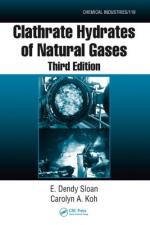|
This section contains 272 words (approx. 1 page at 300 words per page) |
A clathrate is any compound in which one type of molecule is physically enclosed in the crystal structure of a second compound, e.g. a gas is trapped inside a crystal. The properties of the aggregate are essentially those of the enclosing compound.
The molecules SO2, CO2, and CO, as well as the noble gases, form clathrate compounds with cages of open-structured ice or hydroquinone crystals. In ice clathrates, the ice forms a hydrogen- bonded cage enclosing the small guest atoms or molecules. Another example of a clathrate is the benzene-nickel cyanide compound. The petroleum industry has frequently been cursed by hydrocarbon- clathrates blocking gas pipelines in the Arctic regions.
Methane hydrate is an ice-like compound in which methane molecules are enclosed in cavities formed by water molecules. The compound, which looks like ice, forms deposits on the deep ocean floor and in permafrost regions. Most of it is of biological origin. By some estimates, the energy locked up in methane hydrate deposits is more than twice the global reserves of all conventional gas, oil, and coal deposits combined. There has been speculation that methane released from these clathrates could alter climatic conditions in the event of global warming, but no one is really sure just how much methane hydrate exists on Earth.
Liquid clathrates are two-phase systems consisting of an upper layer (typically pure solvent) with a clathrate species residing in a lower layer in a non-stoichiometric, but fixed, proportion of solvent. The solvent is frequently an aromatic species such as toluene, although chloroform has also been used. Liquid clathrates have been of interest in solvent-extraction and coal-liquefaction studies.
|
This section contains 272 words (approx. 1 page at 300 words per page) |


